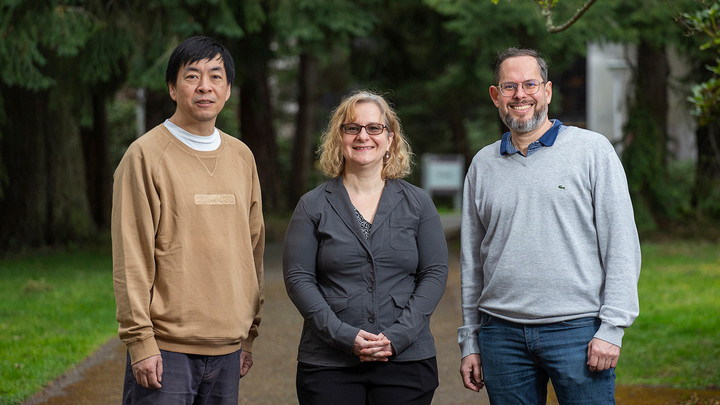More than the unit: entangled photons and an all-star collaboration
May 09, 2024

The smallest discrete unit, a quantum, of scholarship—a researcher—might be compared to the smallest discrete unit, a quantum, of light—a photon. Sometimes, going solo isn’t enough; they simply get more done as a group. In the case of photons, that’s called entanglement. With people, it’s a collaboration.
UVic’s Rogério de Sousa, Irina Paci and Tao Lu (pictured) have assembled a pan-Canadian all-star team of quantum experts. Eleven researchers from six universities and four industry partners have a plan to make quantum processing scalable and commercially viable.
To help them reach that aim, the group has received a five-year $5 million Alliance Consortia Quantum award from the Natural Sciences and Engineering Research Council of Canada.
The project will contribute to the three missions of Canada’s National Quantum Strategy:
- Make Canada a world leader in the continued development, deployment and use of quantum computing hardware and software—to the benefit of Canadian industry, governments and citizens.
- Ensure the privacy and cyber-security of Canadians in a quantum-enabled world through a national secure quantum communications network and a post-quantum cryptography initiative.
- Enable the Government of Canada and key industries to be developers and early adopters of new quantum sensing technologies.
“I thank the vision of Lisa [Kalynchuk],” de Sousa says. “We used the money from the Aspiration Cluster program to hire a grant writer. The Alliance Consortia Quantum grant is a direct consequence of the cluster.”
Qubits
Because photons travel at the speed of light, they provide unique advantages for processing information and for computing. They enable ultrafast operations and can also carry information over long distances as "flying qubits."
However, current quantum computers use optical tables studded with big crystals that manipulate the photons along their journey. These optical tables are big—desk-sized; one of them is able to process up to 100 qubits of information, but not much more than that. In order to process information at the utility scale, they need to be much bigger, a million qubits.
Enter squeezed photons, quantum clusters and entanglement. The aim of the UVic-led project, “Consortium on Integrated Quantum Photonics with Ferroelectric Materials,” is to move quantum photonics off the table and into a chip. By incorporating materials such as barium titanite (BaTiO3) and lithium niobate (LiNbO3) into silicon photonic chips, the researchers will make the photons interact, leading to computations that are out of the reach of conventional supercomputers.
“Our proposal addresses a key issue that the quantum photonics industry is looking at now,” de Sousa says. “There are important applications in sensing, including biosensing, and cryptography. As well, there’s longer term potential for quantum internet, in which quantum computers could collaborate securely.
“This research will provide foundational technologies for secure communications, advanced sensors and quantum computing. It will help position Canada as a leader in chip-based quantum photonics and positively impact the industrial sectors that are key to everyday Canadian life.”
Quanta
In the whispering gallery dome of London’s St. Paul’s Cathedral, a person can face the wall and whisper. The message will be heard by someone standing on the far side of the dome. “It’s as if a ghost is delivering the message,” says Tao Lu, an engineer and physicist. However, scientists now know that clear transportation is the result of sound waves that maintain their energy while travelling over distances.
Lu and others apply the same principles to photons, aka quanta, travelling within an optical whispering gallery microcavity composed of, in this new project, BaTiO3. The more round-trips a photon whizzes around that circuit, the more times it will “see” any other molecules that have landed in there. That’s one way that quanta—single photons—are useful. In addition, the movement of these photons generates a force like a spring. A single protein molecule landing on it will change the spring’s oscillation, and that allows the potential for biosensing and possible diagnostic tools for diseases such as cancer.
Theoretical chemist Irina Paci simulates materials and chemical reactions that make new molecules, or that change chemical processes. By modelling them at the level of atoms and electrons, she can predict how they’ll work and perhaps redesign them to work more effectively. That’s her goal in working with the quantum consortium.
“We want to create and use materials with special optical properties,” she explains. “Photonic materials have many applications. What we learn in these projects will also be useful for other applications.”
The quest
Ultimately, the consortium’s work will create a positive feedback loop. They’ll figure out how to integrate barium titanite and lithium niobite into silicon chips, in order to generate the “secret sauce” of quantum computing, which is quantum entanglement. By producing highly entangled quantum states of light, they will enable quantum photonics technology that will enhance the sensitivity of measurements and accelerate the discovery of novel materials, leading to the design of even better quantum computers.
“One nice thing about collaborative grants,” Paci says of the Alliance Consortia Quantum award, “is that they foster interactions. You talk to industry, to people at other institutions, and new ideas are sparked by these conversations.
“Science fosters new science,” she says. “It’s very exciting.”
UVic Aspiration Research Cluster Program: Quantum Photonics Cluster
About the Quantum Photonics Cluster
Lead: Thomas E. Baker
Canada is an international leader in the development of quantum technologies and has invested significantly to grow institutional capabilities within the country. The Quantum Photonics Cluster will bring together UVic researchers to create a robust collaboration on photonics, algorithms, and light-matter interactions for future technology. The study of new quantum-based technologies and their interaction with light has the potential to revolutionize current technologies over the short and long term, with potential applications for climate and sustainability, and health and wellness.
